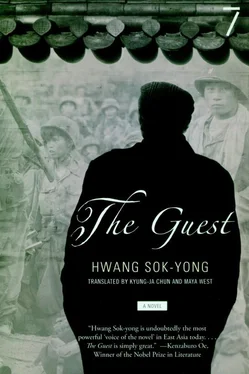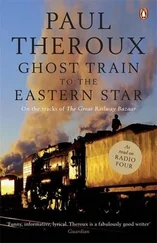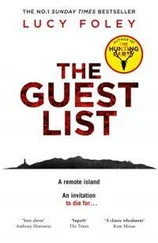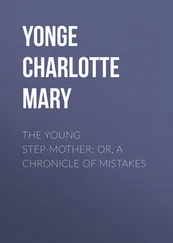These are Reds, too. With Reds, you gotta dry up their seed.
The families are herded out into their yards. Simultaneously, the men load the rifles with a series of loud clicks. It’s the first time in their lives to ever even hold such weapons. For one brief instant, they hesitate. Then they pull their triggers. A shot fired by one’s own gun sounds no louder than the dry crack of a bamboo stick striking a wooden floor. In the darkness, people thud down to the ground before it even occurs to them to scream for help. Once they kill a handful of people, they feel like gods — they are all-powerful. At their next stop, there is no moment of hesitation.
We shouldn’t waste our bullets on ones like these.
Anything they can get their hands on — an axe, a pick, a rake left lying around the yard — anything is good enough. When they run into a group of their own, dragging some Party members out into the street, they mock them.
Hey, hey now, what’s this?
This bastard’s a Party member, and this little thing here is a member of the Women’s League.
Why bother dragging this trash around fully clothed?
Someone leaps on the woman and rips open the front of her chŏgori . The garment is torn in half. They yank her skirt down violently, revealing her underwear and naked thighs. Unable even to scream, she falls to her knees and begs for her life.
Though he’s kept his mouth shut so far, the man who was captured with her protests, You call yourselves men?
Well, well, so the little son of Satan speaks, does he?
At once, they are all over him, beating him mercilessly with the butts of their rifles about the head and back. The man is sprawled out on the ground, soaked in blood, his legs twitching. Someone fires a couple of shots into his back. A bullet is used on the woman as well — in the beginning, there is no rape. Far from it. Many times, after a kill, the young men stand together in a circle to pray together. All throughout Chaeryŏng, the slaughter continues until daybreak.

The U.S. Army has yet to arrive in Haeju. They’ve just passed Munsan and they’re about to cross the Imjin River. The international dispute over the issue on the advance attacks just beyond the thirty-eighth parallel has come to an end, and now the Anticommunist Youth are the only ones infiltrating the seacoast.
The real front is located much farther down, but in order to prepare for the defense of Pyongyang a part of the People’s Army stationed along the western front are beginning to retreat along the railways. They are about the size of a battalion. They run into a number of police officers and young members of the Democratic Youth League, unarmed and out of uniform. Hearing the news that Chaeryŏng has been seized by reactionaries, they stop their march north and begin to move southwest. The men are all from the regular army troops. They are hardened soldiers with a great deal of combat experience, not to mention superior firepower.
The People’s Army divides their troops, sending an advance party on ahead to make a detour around the town of Chaeryŏng. They wait in ambush along the hillside by the road that leads to Sinch’ŏn. They intend to cut off the enemy’s retreat. The plan of attack is to go in from all sides, besiege the town, and send in a heavily armed special unit with mortars to make a frontal assault. Those who escaped the Chaeryŏng County slaughter of the previous night take the lead, acting as guides. Unlike the day before, the Democratic Youth League and men from the police stations are now armed. The sentry post of young rebels who have barricaded the road quickly retreat back into town after firing some shots. The rebels posted in front of the county hall and the other buildings hold their ground for quite a while, shooting from behind piles of sandbags. Twenty minutes after first exchanging shots, as the siege begins to close in on all sides, the rebel line breaks. They flee, running for their lives through the smaller side streets. The rebels have been easily suppressed.
The People’s Army takes care of business resolutely and ruthlessly. Wounded reactionary rebels are shot on the spot. Prisoners, after being sorted out by local Party members, are simply ordered to line up against a wall. They are executed all at once. The police officers and members of the Democratic Youth League who have come back into Chaeryŏng are able to calculate the approximate number of remaining rebels by questioning the prisoners and survivors in town. They muster military forces to ferret out the enemy. They go not only to the homes of known reactionaries but descend upon any and all Christian households. Just like before, entire families are executed in their homes. The troops secure command of the town for two days, waiting for a second party to join them. When the rear guard arrives, they continue their retreat in the direction of Hwangju. These three days and nights in Chaeryŏng plant the seeds for the further bloodshed that is to follow in the Mount Kuwŏl area.

The uprising in Sinch’ŏn does not progress as quickly as the one in Chaeryŏng. It is only on the thirteenth that all the Christian Youth who had gone into hiding are finally contacted. Hundreds of people, however, are reached; the presbytery organizations of the church are still active. Resolving to delay the rebellion until the following day, those in charge of contacting the network of townships agree to meet in Hwasan on the night of the fourteenth.
In the Ch’ansaem funeral house Yohan meets the young men who have come out of hiding, including Cho Sangho, who has come down from Mount Kuwŏl. He accompanies them to the Hwasan ravine. Some of the young men from Mount Kuwŏl are armed with long-barreled rifles, standard issue for North Korean soldiers. Sangho has somehow managed to obtain a Japanese-style magazine rifle — he is wearing it. Yohan sticks a worn-out six-shot revolver into the waist of his trousers. It came into his possession while he was in hiding after the Unification Corps incident.
It is close to midnight when they finally reach the meeting place. The path is blocked by a large rock. Yohan picks up two stones and strikes them against each other several times. He waits for a moment and then someone responds, making the same sound from behind the rock. The person looks out at them, his head jutting out over the boulder. The area is surrounded by rocks, and the forest around them seems thicker because of the darkness. The head whispers, Who’s there?
It’s me. Ryu Yohan.
They walk around the rock and enter. There is a puddle on the other side and a large, open space. In spite of themselves, they are surprised. Judging from the voices chattering under their breath in the dark, there seems to be at least a few dozen men. The youth from the local church who was standing guard at the rock comes forward.
Yohan, we’re in big trouble. We hear Chaeryŏng is in absolute pandemonium.
So. It really happened.
Someone calls out to Yohan from the back of the crowd.
Chairman Ryu — we’re here, too.
It is the youth group leader and the young deacon Yohan had met in Chaeryŏng. They all have rifles slung over their shoulders and cartridge belts at their waists. Some are even equipped with hand grenades. A young man from Mount Kuwŏl who was at Chaeryŏng from Mount Kuwŏl and a man from the Youth Corps call Sangho aside to discuss something. All the young men from Sŏbu Church in Chaeryŏng start speaking to Yohan at the same time.
The People’s Army took over the whole town! My entire
family was murdered!
When did this happen?
We just barely made it out of there!
Читать дальше














